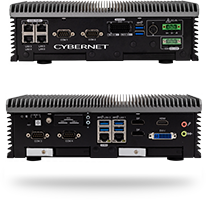If you pay attention to advertising, chances are you see or hear terms like "rugged" and "military-grade" for products or devices used outdoors or in harsh environments. But what does "rugged" actually mean? Is it a meaningful descriptor or just a piece of marketing that sounds nice?
The truth is that rugged designs are often a necessity in harsh work environments. Temperature extremes, powerful vibrations, and high amounts of electrical noise are all threats that industrial panel PCs and tablets face during their work. A design that claims to be rugged must deal with all of these threats.
In today's article, we'll explain why you would use a rugged electronic device over a consumer-grade equivalent, the common threats rugged devices face, and what design features they use to ensure they remain operational even in the harshest conditions.
Why Choose A Rugged Design?
The primary use for rugged industrial computers is in areas that the typical consumer-grade PC simply cannot handle. For instance, computers on offshore oil rigs face brutal working conditions: they must contend with extremely high and low temperatures, constant vibration from the rig's machinery that can damage internal components, and exposure to saltwater that can further corrode and harm the PC.
In such an environment, a standard one would never survive, and similar conditions can be found in other industries such as mining, construction, and manufacturing. Only computers and tablets specifically designed for such harsh conditions can be used safely.
Common Regulatory Standards for Rugged Computers
While any manufacturer can attach the term "rugged" to their devices, a genuinely rugged industrial PC or tablet will have met certain standards or certifications that guarantee its effectiveness. These standards include:
Ingress Protection (IP) Rating: Ingress protection is a measurement of how well a device's casing keeps water and dust out. For example, a device with an IP65 rating is dustproof and protected against water jets, well within the typical needs of an industrial device.
MIL-STD-810G: Military Standard 810G is used by the US Department of Defense for electronic devices used by the military and covers everything from temperature extremes to bullet impacts. While intended for military usage, civilian manufacturers will adapt parts of MIL-STD-810G, such as drop protection and impact resistance, for their own devices.
Common Environmental Hazards and Rugged Features to Counter Them
One of the challenges in designing rugged industrial computers is that there is rarely just one environmental factor to worry about. Rugged tablets and computers often face multiple threats simultaneously, complicating the design process for these devices. What follows are some of the most common dangers rugged electronics face and how they are dealt with.
- Extreme temperatures: Both high and low temperatures can impede a computer's functions or outright damage it. For high temperatures, it is necessary to use conduction cooling; most PCs use fans to provide cooling, but fans are unreliable and vulnerable to vibration-induced damage. Therefore, rugged PCs will use a large heatsink to keep the computer cool. A high ingress protection rating is needed for extremely low temperatures to prevent condensation from forming inside the computer while DC heating is used to bring the internal components within normal operating ranges.
- Mechanical vibration and shock: Areas with heavy machinery often experience extremely heavy vibrations that can literally shake a computer apart. For this reason, rugged PCs typically solder their large integrated circuits directly to the motherboard rather than use sockets or grid arrays. They will also often be designed with shock isolation springs that prevent impacts from reaching the computer's components. This helps ensure the PC does not lose its structural integrity. This is particularly critical for in-vehicle computers, which must often contend with bumpy, uneven roads.
- Electrical discharge: In areas where electrostatic discharge (ESD) is a serious concern, keeping the earth ground close to the chassis and TVS grounds is critical. The computer should also integrate ESD protection circuits to preserve the vulnerable components in the event of a discharge.
- Dust and particulates: If dust and particulates are allowed to settle inside a computer, they can damage the circuits of a computer's processor, memory, or motherboard. Therefore, it is critical to have a tightly sealed case with a high ingress protection (IP) rating.
- Drops and impacts: A major concern for industrial tablets is the chance they will be mishandled or dropped by workers. This requires a durable casing that won't break upon impact and a chemically treated crack-proof display.
Conclusion
Given the extreme conditions they must operate under, industrial PCs and tablets must meet the highest standards for durability. By using devices certified for such a brutal environment, industries can ensure their operations go uninterrupted by equipment failure and enjoy all the efficiency benefits of modern computing solutions.
If your company needs durable, reliable industrial computers or tablets, contact the team at Cybernet Manufacturing. We'd be happy to discuss the applications and end-use cases of our industrial computers and how they can be customized to suit your company's unique needs.
Join the conversation and connect with us on this and other relevant topics - Follow us on Facebook, Twitter, and LinkedIn.


